Abstract
Syndromes of anxiety include generalized anxiety states, various forms of phobic disorder and panic attacks. It is unclear whether panic attacks are a separate syndrome from anxiety states or a more severe form. Drug-induced states of anxiety should provide useful models of the mechanisms of anxiety and its treatment. High-risk populations might be identifiable. Catecholamine infusions produce marked peripheral changes without fully reproducing the central feelings. Lactate infusions also produce anxiety-like states lacking full credibility. Experience with the benzodiazepine-receptor contragonists, the beta-carbolines, is limited but panic states have been reproduced following their use. Caffeine produces an anxiety state in high dose and some panic states have been induced. The critical evaluation of drug-induced anxiety states is a promising way of elucidating the mechanisms, psychological and physiological, associated with clinical anxiety.
Full text
PDF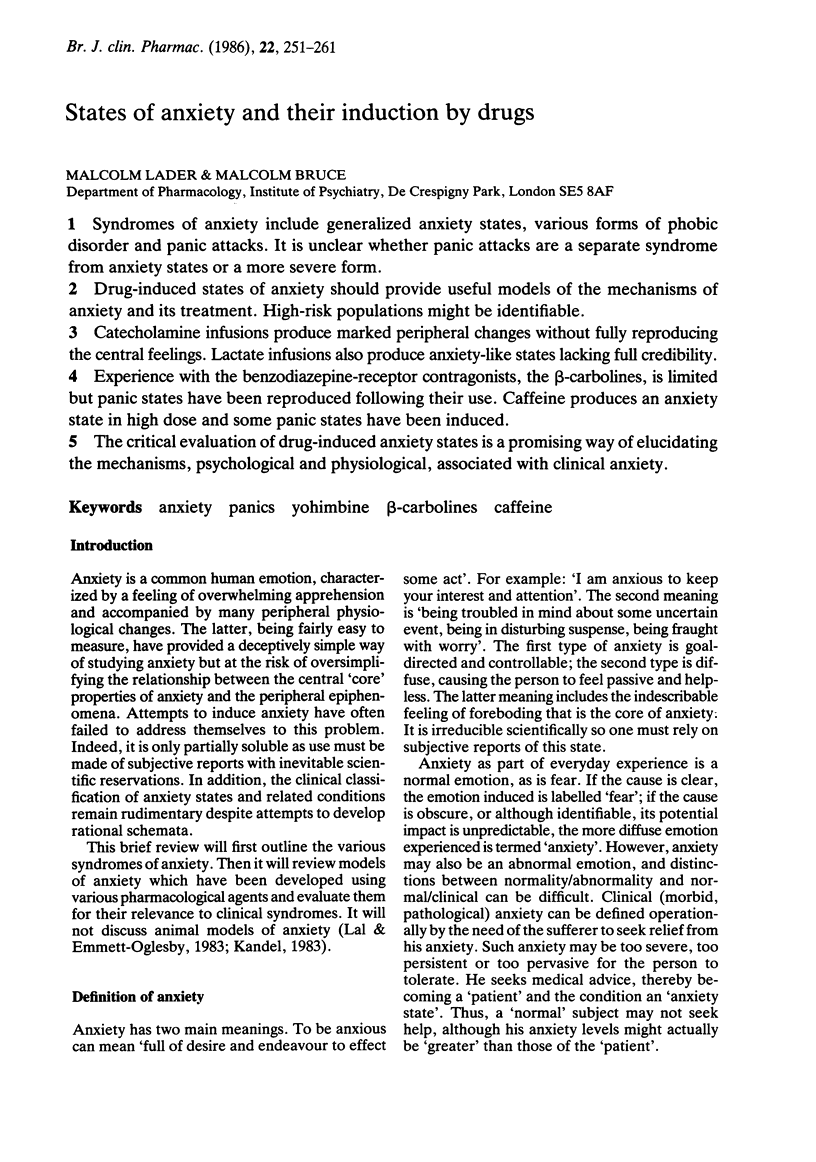
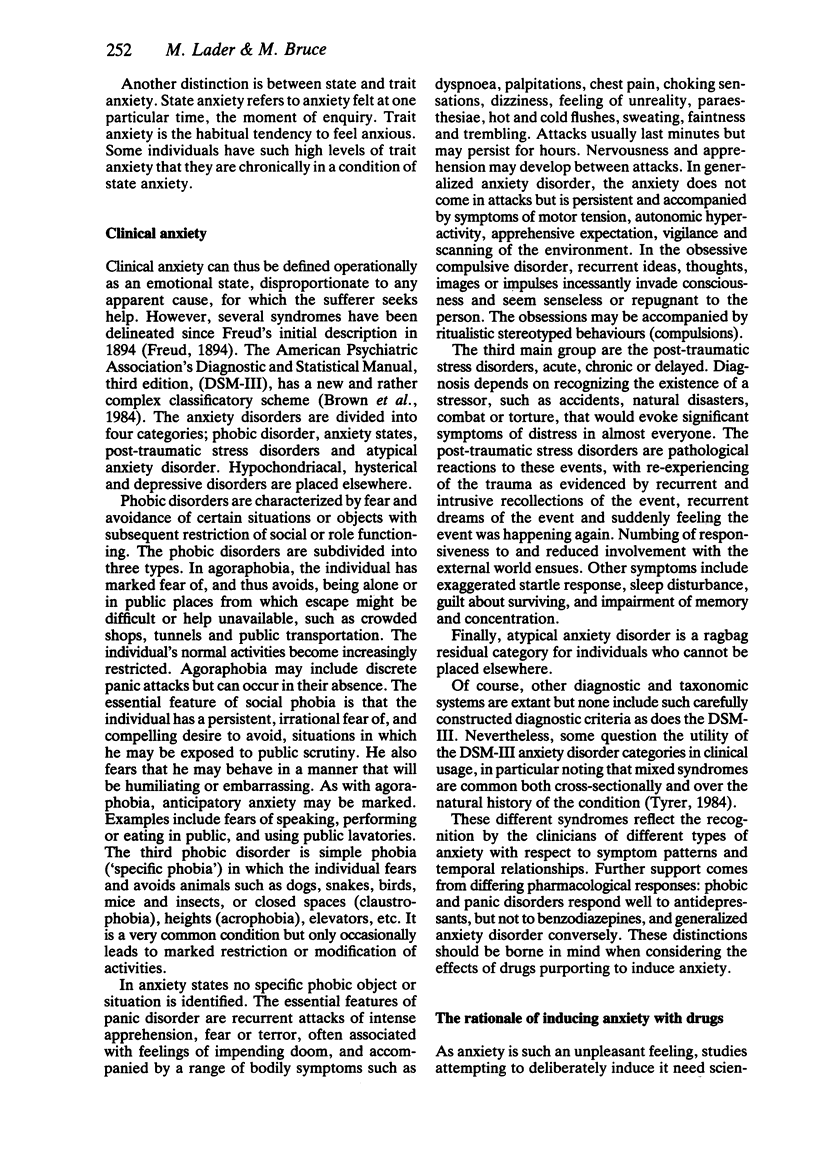
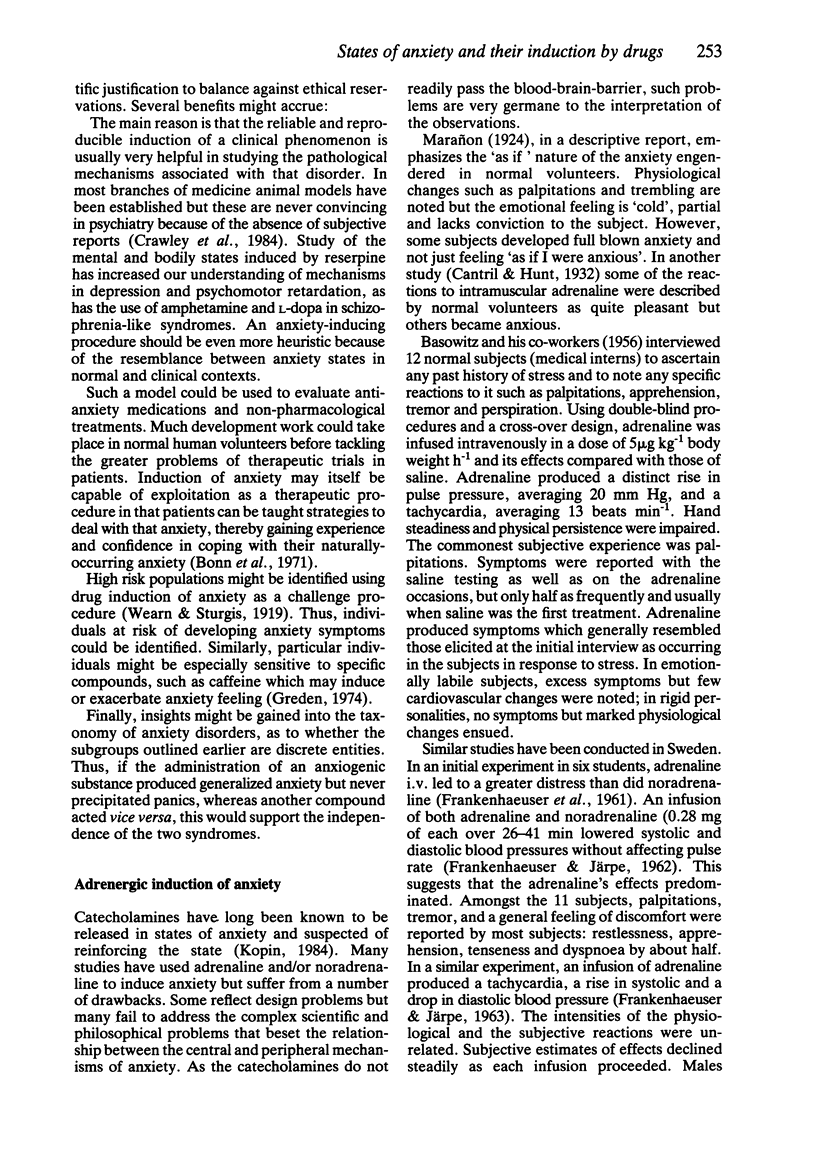
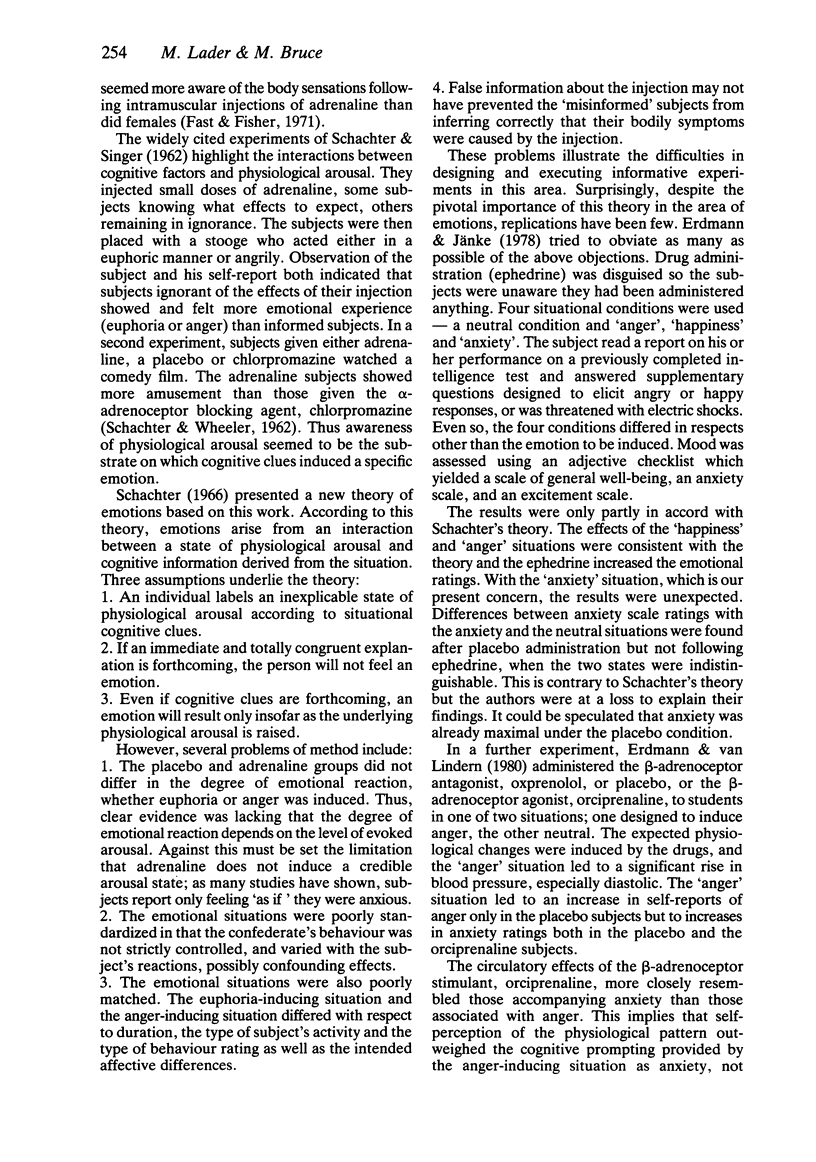
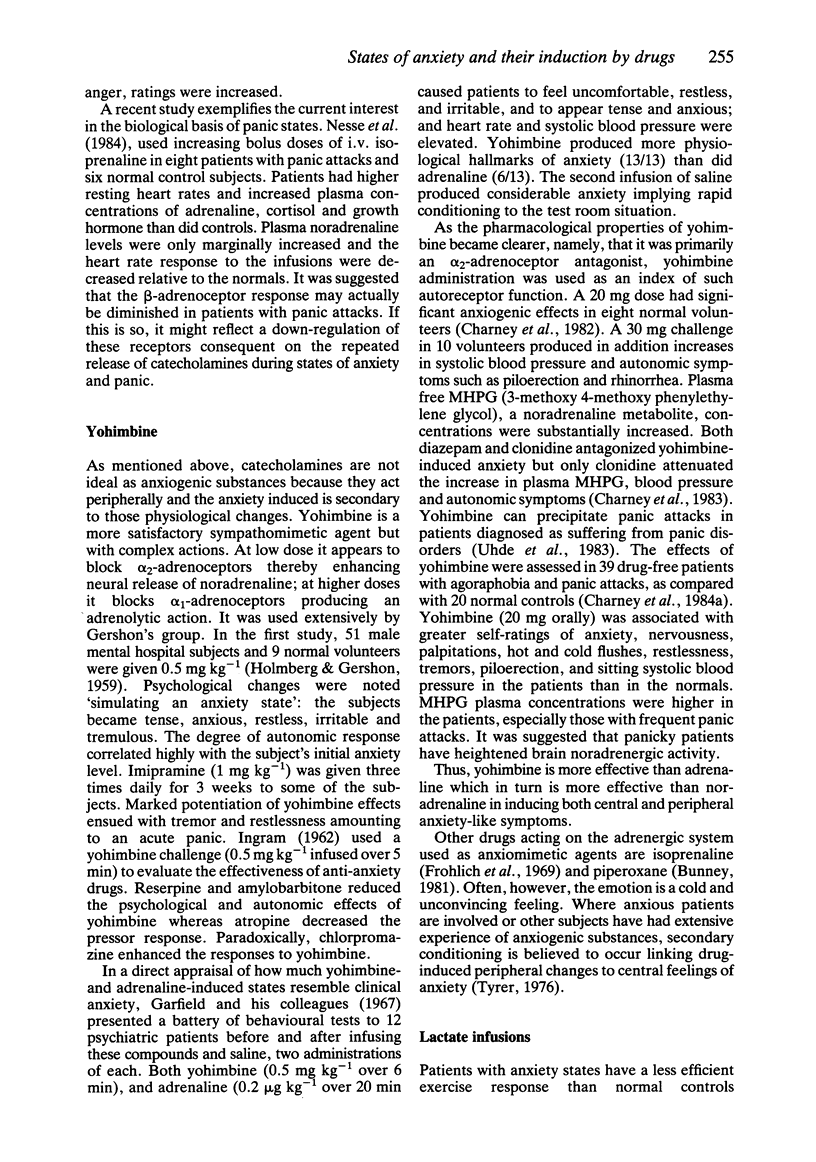
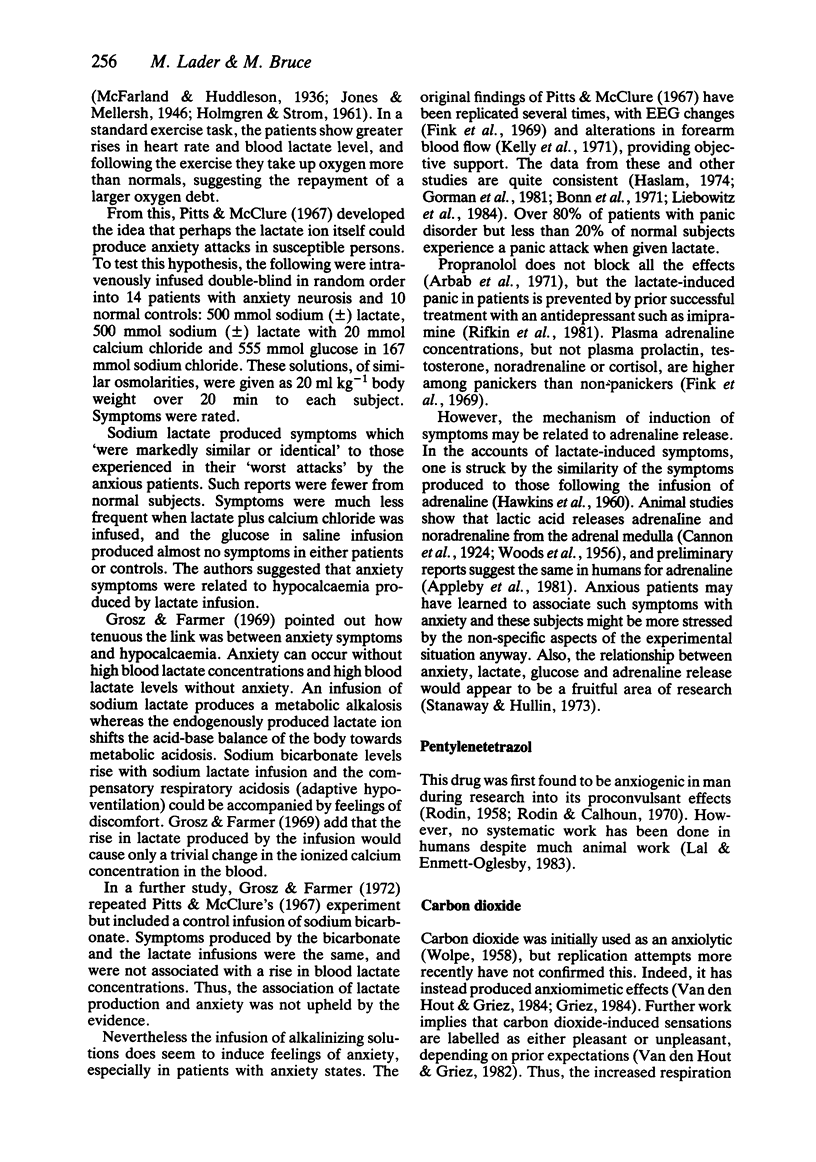
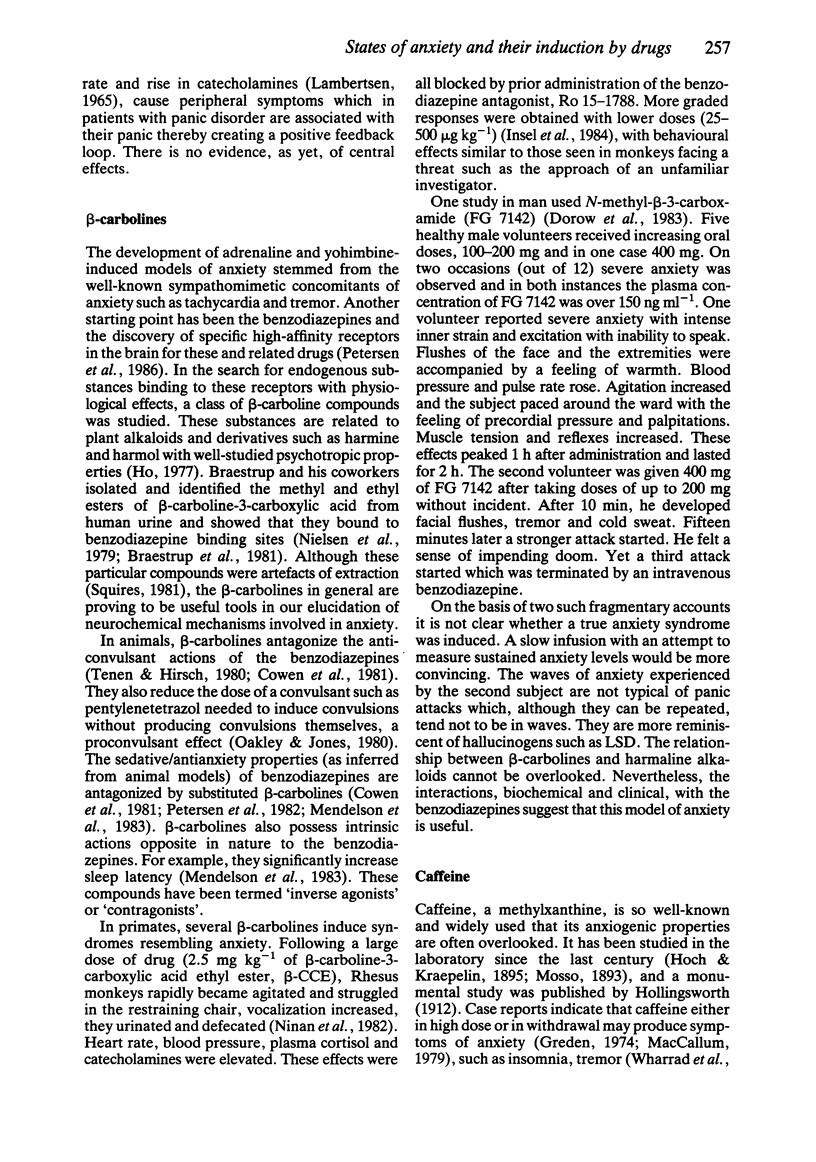
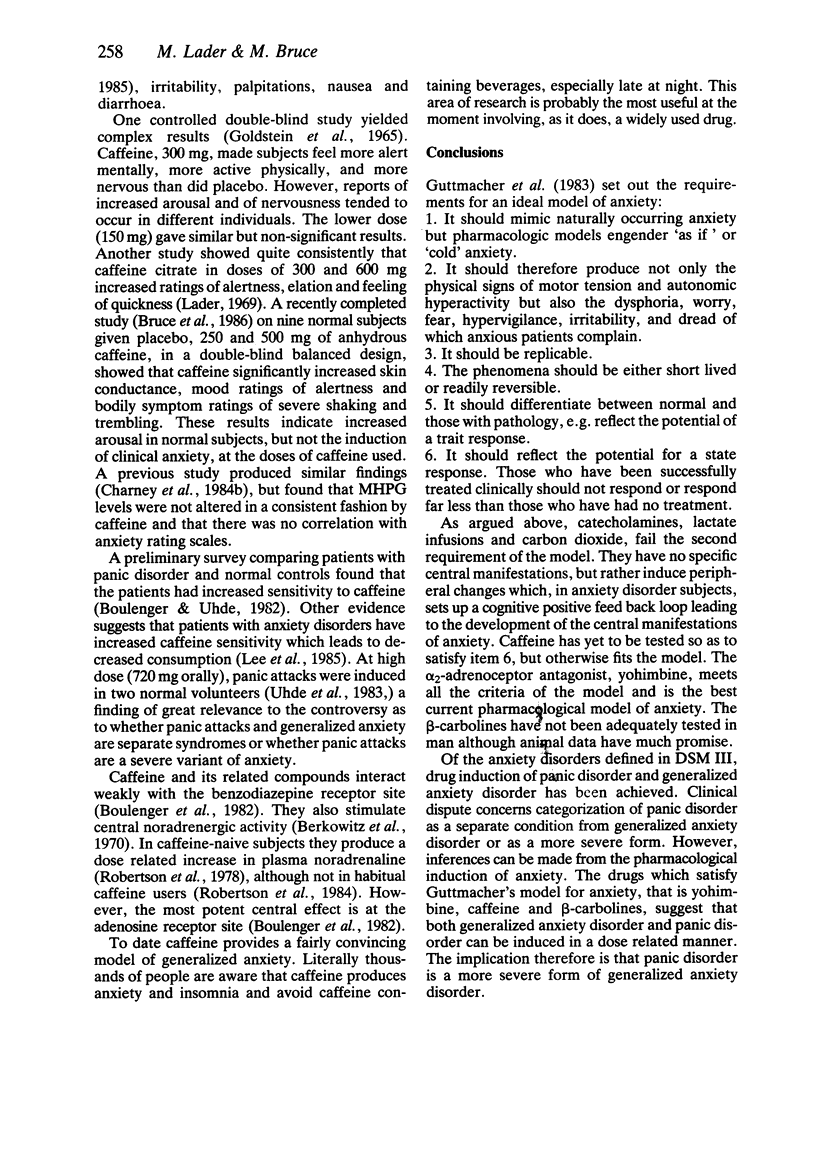
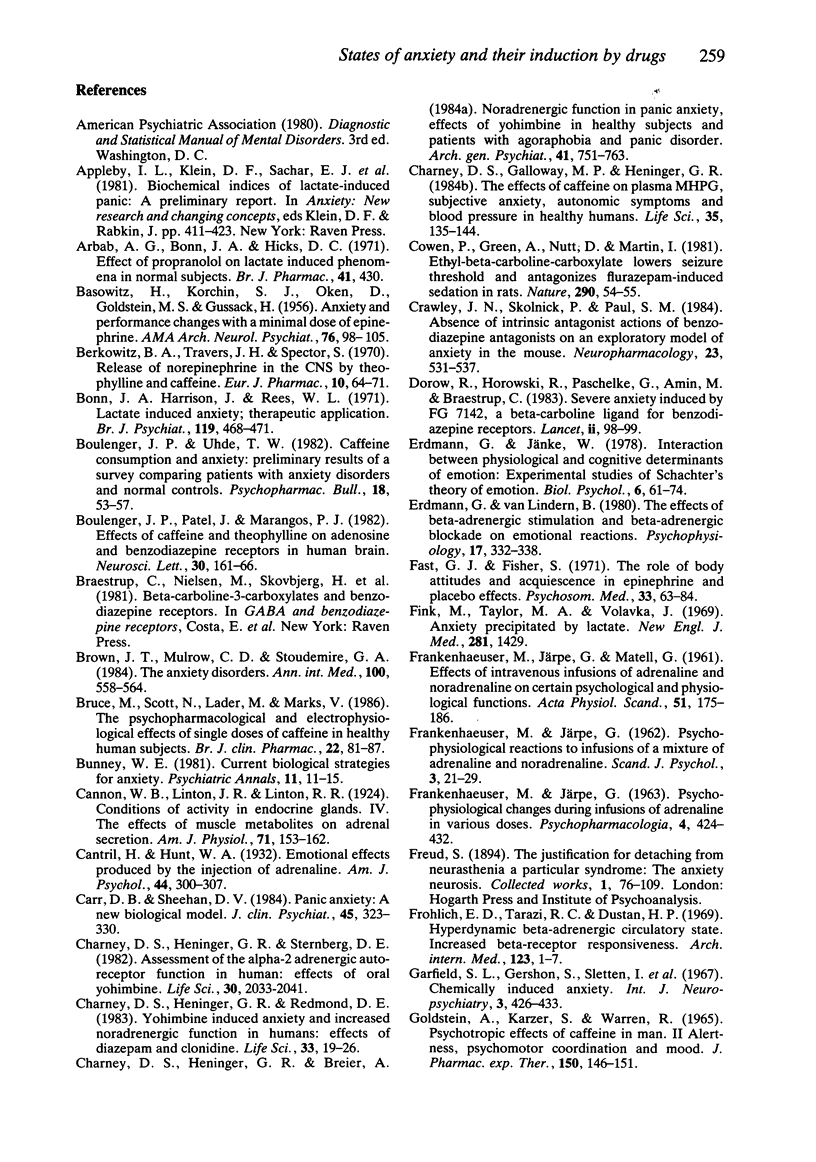
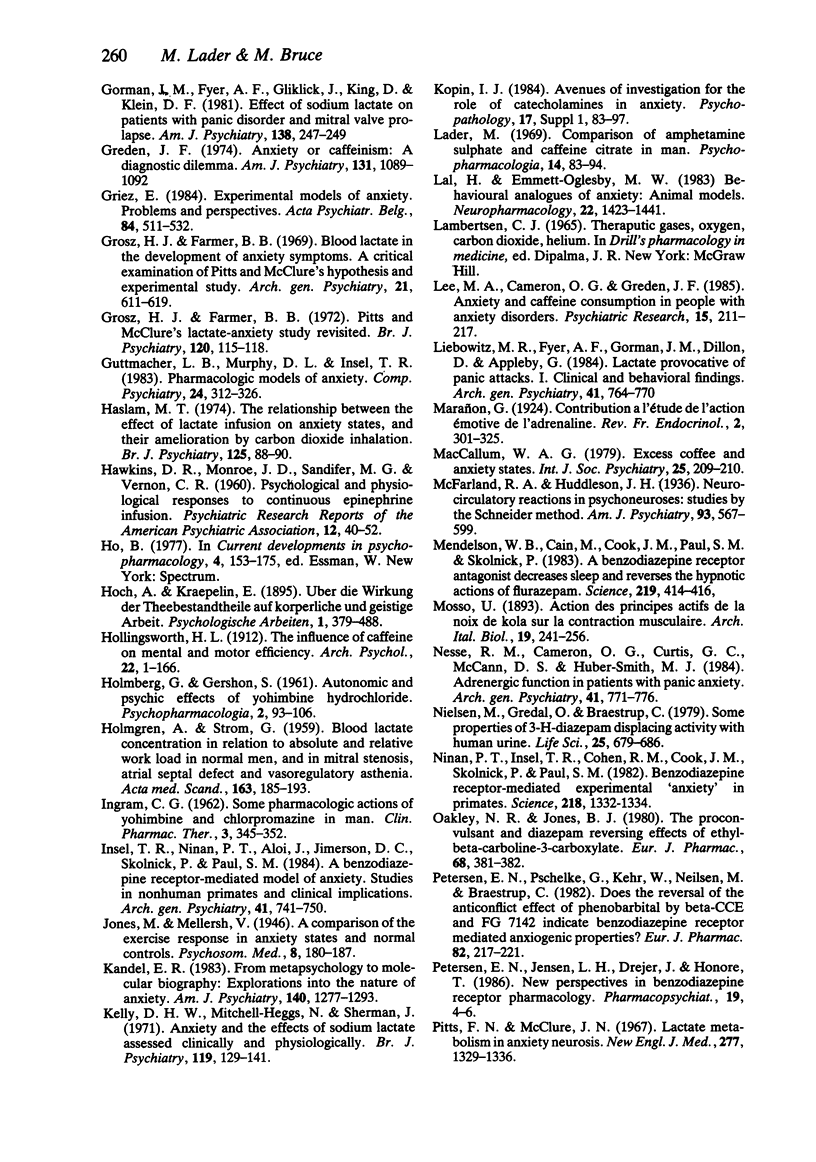
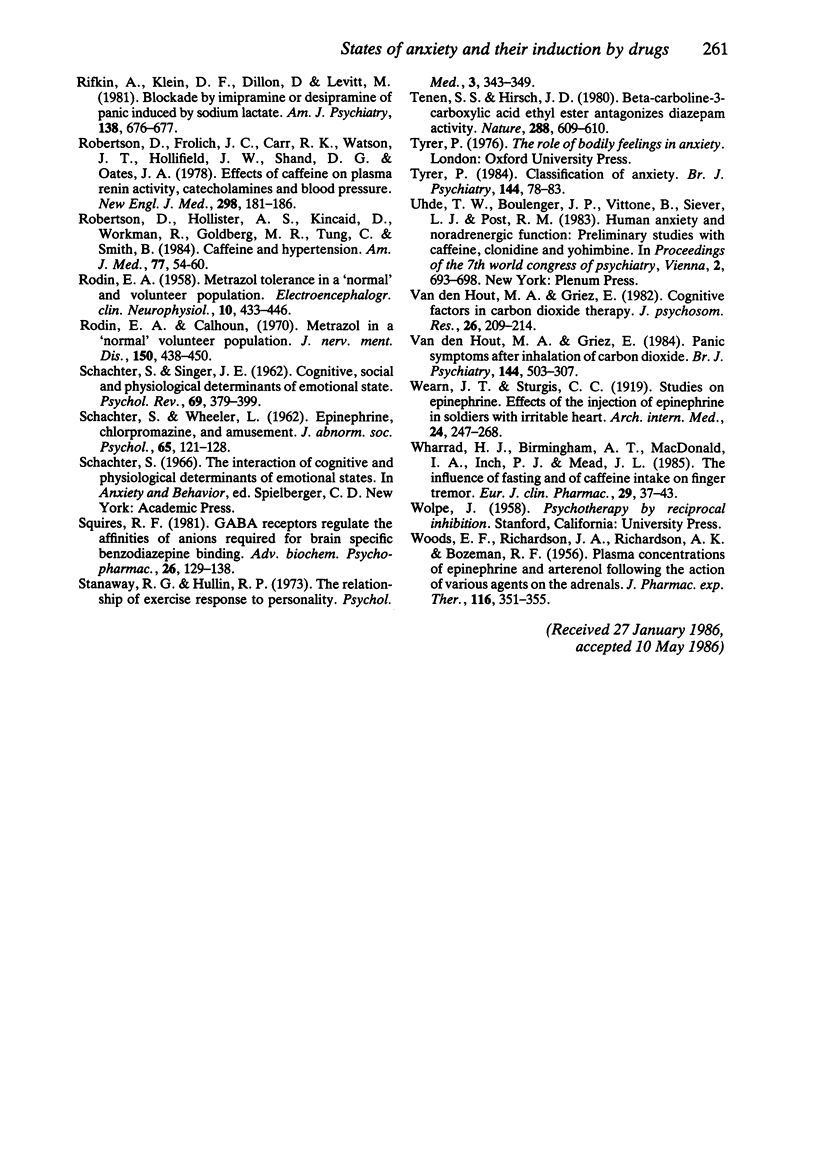
Selected References
These references are in PubMed. This may not be the complete list of references from this article.
- BASOWITZ H., KORCHIN S. J., OKEN D., GOLDSTEIN M. S., GUSSACK H. Anxiety and performance changes with a minimal dose of epinephrine. AMA Arch Neurol Psychiatry. 1956 Jul;76(1):98–106. doi: 10.1001/archneurpsyc.1956.02330250100015. [DOI] [PubMed] [Google Scholar]
- Berkowitz B. A., Tarver J. H., Spector S. Release of norepinephrine in the central nervous system by theophylline and caffeine. Eur J Pharmacol. 1970 Apr;10(1):64–71. doi: 10.1016/0014-2999(70)90158-5. [DOI] [PubMed] [Google Scholar]
- Bonn J. A., Harrison J., Rees W. L. Lactate-induced anxiety: therapeutic application. Br J Psychiatry. 1971 Oct;119(551):468–470. doi: 10.1192/bjp.119.551.468. [DOI] [PubMed] [Google Scholar]
- Boulenger J. P., Patel J., Marangos P. J. Effects of caffeine and theophylline on adenosine and benzodiazepine receptors in human brain. Neurosci Lett. 1982 May 28;30(2):161–166. doi: 10.1016/0304-3940(82)90290-7. [DOI] [PubMed] [Google Scholar]
- Boulenger J. P., Uhde T. W. Caffeine consumption and anxiety: preliminary results of a survey comparing patients with anxiety disorders and normal controls. Psychopharmacol Bull. 1982 Oct;18(4):53–57. [PubMed] [Google Scholar]
- Brown J. T., Mulrow C. D., Stoudemire G. A. The anxiety disorders. Ann Intern Med. 1984 Apr;100(4):558–564. doi: 10.7326/0003-4819-100-4-558. [DOI] [PubMed] [Google Scholar]
- Bruce M., Scott N., Lader M., Marks V. The psychopharmacological and electrophysiological effects of single doses of caffeine in healthy human subjects. Br J Clin Pharmacol. 1986 Jul;22(1):81–87. doi: 10.1111/j.1365-2125.1986.tb02883.x. [DOI] [PMC free article] [PubMed] [Google Scholar]
- Carr D. B., Sheehan D. V. Panic anxiety: a new biological model. J Clin Psychiatry. 1984 Aug;45(8):323–330. [PubMed] [Google Scholar]
- Charney D. S., Galloway M. P., Heninger G. R. The effects of caffeine on plasma MHPG, subjective anxiety, autonomic symptoms and blood pressure in healthy humans. Life Sci. 1984 Jul 9;35(2):135–144. doi: 10.1016/0024-3205(84)90132-2. [DOI] [PubMed] [Google Scholar]
- Charney D. S., Heninger G. R., Breier A. Noradrenergic function in panic anxiety. Effects of yohimbine in healthy subjects and patients with agoraphobia and panic disorder. Arch Gen Psychiatry. 1984 Aug;41(8):751–763. doi: 10.1001/archpsyc.1984.01790190025003. [DOI] [PubMed] [Google Scholar]
- Charney D. S., Heninger G. R., Redmond D. E., Jr Yohimbine induced anxiety and increased noradrenergic function in humans: effects of diazepam and clonidine. Life Sci. 1983 Jul 4;33(1):19–29. doi: 10.1016/0024-3205(83)90707-5. [DOI] [PubMed] [Google Scholar]
- Charney D. S., Heninger G. R., Sternberg D. E. Assessment of alpha 2 adrenergic autoreceptor function in humans: effects of oral yohimbine. Life Sci. 1982 Jun 7;30(23):2033–2041. doi: 10.1016/0024-3205(82)90444-1. [DOI] [PubMed] [Google Scholar]
- Cowen P. J., Green A. R., Nutt D. J. Ethyl beta-carboline carboxylate lowers seizure threshold and antagonizes flurazepam-induced sedation in rats. Nature. 1981 Mar 5;290(5801):54–55. doi: 10.1038/290054a0. [DOI] [PubMed] [Google Scholar]
- Crawley J. N., Skolnick P., Paul S. M. Absence of intrinsic antagonist actions of benzodiazepine antagonists on an exploratory model of anxiety in the mouse. Neuropharmacology. 1984 May;23(5):531–537. doi: 10.1016/0028-3908(84)90026-1. [DOI] [PubMed] [Google Scholar]
- Dorow R., Horowski R., Paschelke G., Amin M. Severe anxiety induced by FG 7142, a beta-carboline ligand for benzodiazepine receptors. Lancet. 1983 Jul 9;2(8341):98–99. doi: 10.1016/s0140-6736(83)90076-4. [DOI] [PubMed] [Google Scholar]
- Erdmann G., Janke W. Interaction between physiological and cognitive determinants of emotions: experimental studies on Schachter's theory of emotions. Biol Psychol. 1978 Jan;6(1):61–74. doi: 10.1016/0301-0511(78)90007-8. [DOI] [PubMed] [Google Scholar]
- Erdmann G., van Lindern B. The effects of beta-adrenergic stimulation and beta-adrenergic blockade on emotional reactions. Psychophysiology. 1980 Jul;17(4):332–338. doi: 10.1111/j.1469-8986.1980.tb00158.x. [DOI] [PubMed] [Google Scholar]
- FRANKENHAEUSER M., JAERPE G. PSYCHOPHYSIOLOGICAL CHANGES DURING INFUSIONS OF ADRENALINE IN VARIOUS DOSES. Psychopharmacologia. 1963 Aug 20;4:424–432. doi: 10.1007/BF00403347. [DOI] [PubMed] [Google Scholar]
- FRANKENHAEUSER M., JARPE G., MATELL G. Effects of intravenous infusions of adrenaline and noradrenaline on certain psychological and physiological functions. Acta Physiol Scand. 1961 Feb-Mar;51:175–186. doi: 10.1111/j.1748-1716.1961.tb02126.x. [DOI] [PubMed] [Google Scholar]
- Fast G. J., Fisher S. The role of body attitudes and acquiescence in epinephrine and placebo effects. Psychosom Med. 1971 Jan-Feb;33(1):63–84. doi: 10.1097/00006842-197101000-00005. [DOI] [PubMed] [Google Scholar]
- Fink M., Taylor M. A., Volavka J. Anxiety precipitated by lactate. N Engl J Med. 1969 Dec 18;281(25):1429–1429. doi: 10.1056/NEJM196912182812524. [DOI] [PubMed] [Google Scholar]
- Frohlich E. D., Tarazi R. C., Dustan H. P. Hyperdynamic beta-adrenergic circulatory state. Increased beta-receptor responsiveness. Arch Intern Med. 1969 Jan;123(1):1–7. [PubMed] [Google Scholar]
- Goldstein A., Kaizer S., Warren R. Psychotropic effects of caffeine in man. II. Alertness, psychomotor coordination, and mood. J Pharmacol Exp Ther. 1965 Oct;150(1):146–151. [PubMed] [Google Scholar]
- Gorman J. M., Fyer A. F., Gliklich J., King D., Klein D. F. Effect of sodium lactate on patients with panic disorder and mitral valve prolapse. Am J Psychiatry. 1981 Feb;138(2):247–249. doi: 10.1176/ajp.138.2.247. [DOI] [PubMed] [Google Scholar]
- Greden J. F. Anxiety or caffeinism: a diagnostic dilemma. Am J Psychiatry. 1974 Oct;131(10):1089–1092. doi: 10.1176/ajp.131.10.1089. [DOI] [PubMed] [Google Scholar]
- Griez E. Experimental models of anxiety. Problems and perspectives. Acta Psychiatr Belg. 1984;84:511–532. [PubMed] [Google Scholar]
- Grosz H. J., Farmer B. B. Blood lactate in the development of anxiety symptoms. A critical examination of Pitts and McClure's hypothesis and experimental study. Arch Gen Psychiatry. 1969 Nov;21(5):611–619. doi: 10.1001/archpsyc.1969.01740230099014. [DOI] [PubMed] [Google Scholar]
- Guttmacher L. B., Murphy D. L., Insel T. R. Pharmacologic models of anxiety. Compr Psychiatry. 1983 Jul-Aug;24(4):312–326. doi: 10.1016/0010-440x(83)90059-7. [DOI] [PubMed] [Google Scholar]
- HAWKINS D. R., MONROE J. T., SANDIFER M. G., VERNON C. R. Psychological and physiological responses to continuous epinephrine infusion--an approach to the study of the affect, anxiety. Psychiatr Res Rep Am Psychiatr Assoc. 1960 Jan;12:40–52. [PubMed] [Google Scholar]
- HOLMBERG G., GERSHON S. Autonomic and psychic effects of yohimbine hydrochloride. Psychopharmacologia. 1961;2:93–106. doi: 10.1007/BF00592678. [DOI] [PubMed] [Google Scholar]
- HOLMGREN A., STROM G. Blood lactate concentration in relation to absolute and relative work load in normal men, and in mitral stenosis, atrial septal defect and vasoregulatory asthenia. Acta Med Scand. 1959 Mar 4;163(3):185–193. doi: 10.1111/j.0954-6820.1959.tb10399.x. [DOI] [PubMed] [Google Scholar]
- Haslam M. T. The relationship between the effect of lactate infusion on anxiety states, and their amelioration by carbon dioxide inhalation. Br J Psychiatry. 1974 Jul;125(0):88–90. doi: 10.1192/bjp.125.1.88. [DOI] [PubMed] [Google Scholar]
- Insel T. R., Ninan P. T., Aloi J., Jimerson D. C., Skolnick P., Paul S. M. A benzodiazepine receptor-mediated model of anxiety. Studies in nonhuman primates and clinical implications. Arch Gen Psychiatry. 1984 Aug;41(8):741–750. doi: 10.1001/archpsyc.1984.01790190015002. [DOI] [PubMed] [Google Scholar]
- Kandel E. R. From metapsychology to molecular biology: explorations into the nature of anxiety. Am J Psychiatry. 1983 Oct;140(10):1277–1293. doi: 10.1176/ajp.140.10.1277. [DOI] [PubMed] [Google Scholar]
- Kelly D., Mitchell-Heggs N., Sherman D. Anxiety and the effects of sodium lactate assessed clinically and physiologically. Br J Psychiatry. 1971 Aug;119(549):129–141. doi: 10.1192/bjp.119.549.129. [DOI] [PubMed] [Google Scholar]
- Kopin I. J. Avenues of investigation for the role of catecholamines in anxiety. Psychopathology. 1984;17 (Suppl 1):83–97. doi: 10.1159/000284081. [DOI] [PubMed] [Google Scholar]
- Lader M. Comparison of amphetamine sulphate and caffeine citrate in man. Psychopharmacologia. 1969;14(2):83–94. doi: 10.1007/BF00403681. [DOI] [PubMed] [Google Scholar]
- Lal H., Emmett-Oglesby M. W. Behavioral analogues of anxiety. Animal models. Neuropharmacology. 1983 Dec;22(12B):1423–1441. doi: 10.1016/0028-3908(83)90111-9. [DOI] [PubMed] [Google Scholar]
- Lee M. A., Cameron O. G., Greden J. F. Anxiety and caffeine consumption in people with anxiety disorders. Psychiatry Res. 1985 Jul;15(3):211–217. doi: 10.1016/0165-1781(85)90078-2. [DOI] [PubMed] [Google Scholar]
- Liebowitz M. R., Fyer A. J., Gorman J. M., Dillon D., Appleby I. L., Levy G., Anderson S., Levitt M., Palij M., Davies S. O. Lactate provocation of panic attacks. I. Clinical and behavioral findings. Arch Gen Psychiatry. 1984 Aug;41(8):764–770. doi: 10.1001/archpsyc.1984.01790190038004. [DOI] [PubMed] [Google Scholar]
- MacCallum W. A. Excess coffee and anxiety states. Int J Soc Psychiatry. 1979 Autumn;25(3):209–210. doi: 10.1177/002076407902500307. [DOI] [PubMed] [Google Scholar]
- Mendelson W. B., Cain M., Cook J. M., Paul S. M., Skolnick P. A benzodiazepine receptor antagonist decreases sleep and reverses the hypnotic actions of flurazepam. Science. 1983 Jan 28;219(4583):414–416. doi: 10.1126/science.6294835. [DOI] [PubMed] [Google Scholar]
- Nesse R. M., Cameron O. G., Curtis G. C., McCann D. S., Huber-Smith M. J. Adrenergic function in patients with panic anxiety. Arch Gen Psychiatry. 1984 Aug;41(8):771–776. doi: 10.1001/archpsyc.1984.01790190045005. [DOI] [PubMed] [Google Scholar]
- Nielsen M., Gredal O., Braestrup C. Some properties of 3H-diazepam displacing activity from human urine. Life Sci. 1979 Aug 20;25(8):679–686. doi: 10.1016/0024-3205(79)90509-5. [DOI] [PubMed] [Google Scholar]
- Ninan P. T., Insel T. M., Cohen R. M., Cook J. M., Skolnick P., Paul S. M. Benzodiazepine receptor-mediated experimental "anxiety" in primates. Science. 1982 Dec 24;218(4579):1332–1334. doi: 10.1126/science.6293059. [DOI] [PubMed] [Google Scholar]
- Oakley N. R., Jones B. J. The proconvulsant and diazepam-reversing effects of ethyl-beta-carboline-3-carboxylate. Eur J Pharmacol. 1980 Dec 5;68(3):381–382. doi: 10.1016/0014-2999(80)90538-5. [DOI] [PubMed] [Google Scholar]
- Petersen E. N., Paschelke G., Kehr W., Nielsen M., Braestrup C. Does the reversal of the anticonflict effect of phenobarbital by beta-CCE and FG 7142 indicate benzodiazepine receptor-mediated anxiogenic properties? Eur J Pharmacol. 1982 Aug 27;82(3-4):217–221. doi: 10.1016/0014-2999(82)90517-9. [DOI] [PubMed] [Google Scholar]
- Pitts F. N., Jr, McClure J. N., Jr Lactate metabolism in anxiety neurosis. N Engl J Med. 1967 Dec 21;277(25):1329–1336. doi: 10.1056/NEJM196712212772502. [DOI] [PubMed] [Google Scholar]
- RODIN E. Metrazol tolerance in a normal voluntser population; an investigation of the potential significance of abnormal findings. Electroencephalogr Clin Neurophysiol. 1958 Aug;10(3):433–446. doi: 10.1016/0013-4694(58)90005-1. [DOI] [PubMed] [Google Scholar]
- Rifkin A., Klein D. F., Dillon D., Levitt M. Blockade by imipramine or desipramine of panic induced by sodium lactate. Am J Psychiatry. 1981 May;138(5):676–677. doi: 10.1176/ajp.138.5.676. [DOI] [PubMed] [Google Scholar]
- Robertson D., Frölich J. C., Carr R. K., Watson J. T., Hollifield J. W., Shand D. G., Oates J. A. Effects of caffeine on plasma renin activity, catecholamines and blood pressure. N Engl J Med. 1978 Jan 26;298(4):181–186. doi: 10.1056/NEJM197801262980403. [DOI] [PubMed] [Google Scholar]
- Robertson D., Hollister A. S., Kincaid D., Workman R., Goldberg M. R., Tung C. S., Smith B. Caffeine and hypertension. Am J Med. 1984 Jul;77(1):54–60. doi: 10.1016/0002-9343(84)90435-2. [DOI] [PubMed] [Google Scholar]
- Rodin E. A., Calhoun H. D. Metrazol tolerance in a "normal" volunteer population. A ten year follow-up report. J Nerv Ment Dis. 1970 Jun;150(6):438–443. doi: 10.1097/00005053-197006000-00003. [DOI] [PubMed] [Google Scholar]
- SCHACHTER S., SINGER J. E. Cognitive, social, and physiological determinants of emotional state. Psychol Rev. 1962 Sep;69:379–399. doi: 10.1037/h0046234. [DOI] [PubMed] [Google Scholar]
- SCHACHTER S., WHEELER L. Epinephrine, chlorpromazine, and amusement. J Abnorm Soc Psychol. 1962 Aug;65:121–128. doi: 10.1037/h0040391. [DOI] [PubMed] [Google Scholar]
- Squires R. F. GABA receptors regulate the affinities of anions required for brain specific benzodiazepine binding. Adv Biochem Psychopharmacol. 1981;26:129–138. [PubMed] [Google Scholar]
- Stanaway R. G., Hullin R. P. The relationship of exercise response to personality. Psychol Med. 1973 Aug;3(3):343–349. doi: 10.1017/s0033291700049643. [DOI] [PubMed] [Google Scholar]
- Tenen S. S., Hirsch J. D. beta-Carboline-3-carboxylic acid ethyl ester antagonizes diazepam activity. Nature. 1980 Dec 11;288(5791):609–610. doi: 10.1038/288609a0. [DOI] [PubMed] [Google Scholar]
- Tyrer P. Classification of anxiety. Br J Psychiatry. 1984 Jan;144:78–83. doi: 10.1192/bjp.144.1.78. [DOI] [PubMed] [Google Scholar]
- Van den Hout M. A., Griez E. Panic symptoms after inhalation of carbon dioxide. Br J Psychiatry. 1984 May;144:503–507. doi: 10.1192/bjp.144.5.503. [DOI] [PubMed] [Google Scholar]
- WOODS E. F., RICHARDSON J. A., RICHARDSON A. K., BOZEMAN R. F., Jr Plasma concentrations of epinephrine and arterenol following the actions of various agents on the adrenals. J Pharmacol Exp Ther. 1956 Mar;116(3):351–355. [PubMed] [Google Scholar]
- Wharrad H. J., Birmingham A. T., Macdonald I. A., Inch P. J., Mead J. L. The influence of fasting and of caffeine intake on finger tremor. Eur J Clin Pharmacol. 1985;29(1):37–43. doi: 10.1007/BF00547366. [DOI] [PubMed] [Google Scholar]
- van den Hout M. A., Griez E. Cognitive factors in carbon dioxide therapy. J Psychosom Res. 1982;26(2):209–214. doi: 10.1016/0022-3999(82)90038-1. [DOI] [PubMed] [Google Scholar]


